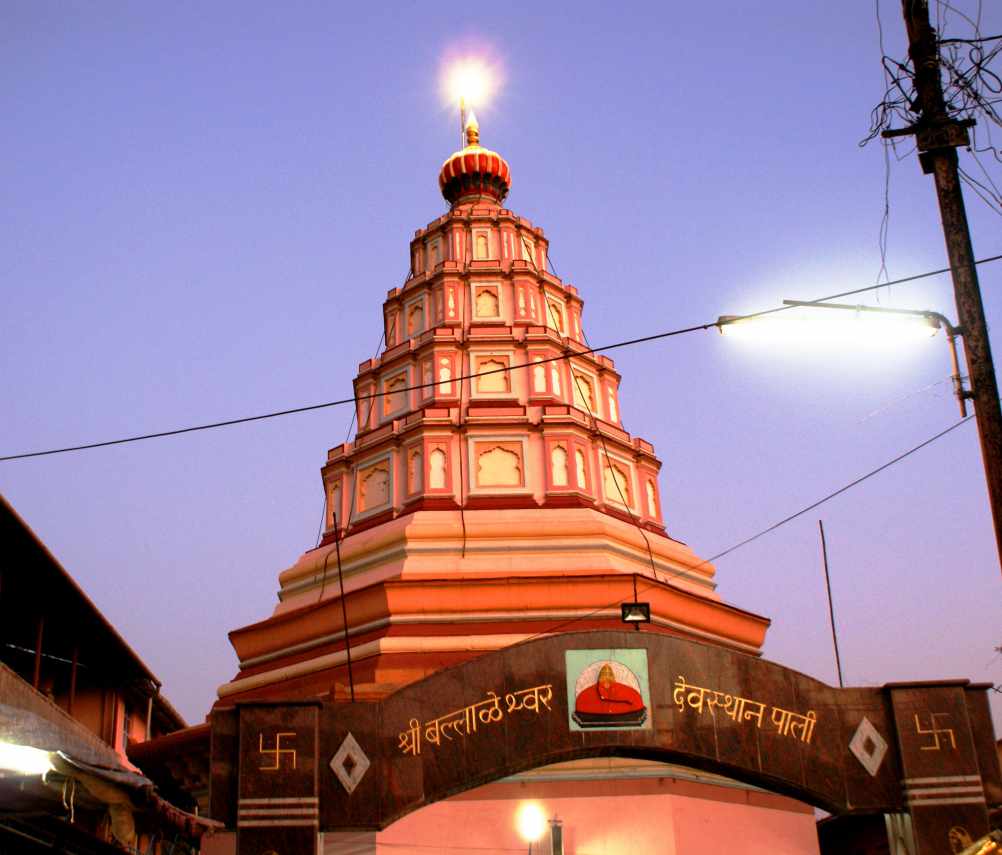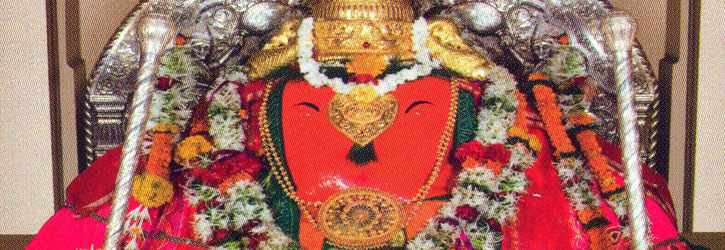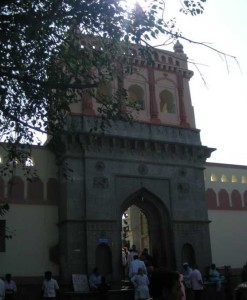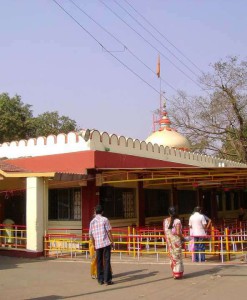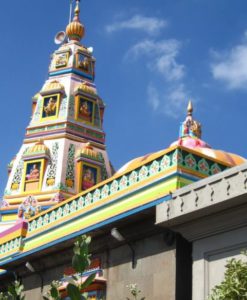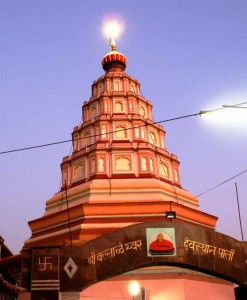No products in the cart.
Shri Ballaleshwar Pali Ganpati temple is one of the eight major temples of Lord Ganesha which constitutes the divine Ashtavinayak temples. Among Ganesha temples, Ballaleshwar is the only incarnation of Ganesha that is known by his devotee’s name. It is located in the village of Pali which is at a distance of 30 km from Karjat in the Raigad district. It is situated between fort Sarasgad and the river Amba. The deity is said to be famous for quick response to the prayers.
The Idol of Vinayaka sitting on a stone throne, faces east & its trunk is turned left. The idol has two diamonds in his eyes and one in the navel. The background is of silver where one finds Riddhi & Siddhi waving Chamaras.
The present temple’s construction work is said to have been done by Shri Phadnis of Moradabad. It was built in such a way that it was in the form of the word श्री (Shree) & faced the east so that the rays of the Sun would fall directly on the deity. The main feature of this temple is the 15 foot high sanctum & the gigantic metal bell of the temple made in Europe. After defeating the Portuguese in Vasai & Sasthi, Chimaji Appa brought these bells & offered them at different Ashtavinayak places.
The Ballaleshwar Pali Ganpati temple is the only temple of Ganesh, famous by the name of his devotee and who is dressed up like a Brahmin. The Temple complex is tiled & it encircles two lakes. Water of one lake towards right is reserved for Vinayaks’s Pooja.
There are two Sanctums (Girbhagriha) in the temple. Inner sanctum is quite big & is 15 feet high. Outer sanctum is 12 feet high & it has a rat idol with a Modak in his hands & facing Ganesh. Temple walls are made quite strong by mixing lead with cement while constructin. Hall of the temple is 40 feet long & 20 feet broad & it was built by late Shri Krishnaji Ringe in 1910 A.D. The Hall is very beautiful with 8 pillars resembling cyprus throne tree. The temple peak (Kalas) is adorned with golden sheet as a result of donations by devotees. The palakhi used for procession is also covered with silver plates. This also has come from donations. The bathing utensils like circular pot (Ghangal) and sitting device (chaurang) upper arms of the idol and central hanging (zumber) are covered fully with silver plates. Gold and silver crowns decorating the idol and fish are donated by devotees.
Ballaleshwar Pali Ganpati Temple, Maharashtra
Legend of this Ashtavinayak is associated with the devotion of a boy called Ballala to Lord Ganesh. Ballala was an ardent devotee of Lord Ganesh. One day he organized a special pooja in his village- Pali. He invited all other children of that village to take part in that. The pooja went on for several days: devoted children refused to return home before the completion of the pooja by Ballala. This annoyed the parents; they complained to Kalyani Seth- father of Ballala. Kalyani seth went to the place where the pooja was taking place. He threw the Ganesh idol worshiped by the boy into forest; beaten him up severely. A seriously injured Ballala, though tired, continued with chanting Lord Ganesh prayers. Pleased with the devotion of the boy, Lord Ganesh appeared before him and healed Ballala. The boy requested Lord Ganesh to take abode at his village. The Lord Ganesh agreed and told Ballala that he will be known here by the boy’s name.
That stone statue is called Ballaleshwar. The stone idol which Kalyan threw to the ground is also known as Dhundi Vinayak. This is a swayambhu murti and is worshiped before Ballaleshwar is worshiped.
On every Chaturthi day the idol is offered panchamrut snanam (bath), Royal dress, Naivadya, Aarti, Palakhi and mantrapushpam in the evening. There are discourses from Aashadhi Ekadashi to Kartik Ekadashi on various subjects. After procession of holy book on Kartik Ekadashi discourse session ends. The idol is decorated with ornaments made of Gold and silver and rich clothes on the occasion of Chaturthi and various celebrations. Devotees make 21 pradkshinas (holy rounds) of Ganpati to get their desires fullfilled & problems solved.
A unique occurrence is said to take place on the 4th day of Bhadrapa, when Maha Bhog is offered to the temple’s deity: it is believed that the imprint of the deity’s fingers can be seen on the offerings. That is why on this day you will the maximum number of devotees at this temple. A not to be missed occasion is the palki procession on the 3rd day of Magh. On this day, the temple deity is taken around the town in a beautiful flower-bedecked palki (palanquin) with devotees walking along behind it, singing the Lord’s praises.
The gates of the temple open at dawn 5.30 a.m. and closes for darshan at 10.00 p.m. In any case, it is not opened before 5.30 a.m. Devotees can enter inner section of the temple from 5.30 a.m. with special cloth of puja and perform puja through pujaris deputed by trust. Only on Chaturthi days the timing of such puja is between 6.00 a.m. to 9.00a.m.
Bhadrapadi Utsav (Bhadrapad Shuddha Pratipada to Panchami) and Maghi Utsav (Magh Shuddha Pratipada to Panchami) are the two main celebrations organized in the presence local literates and eminent scholars, Bhajans, kirtan (discourse) form the part of celebrations. Birth highlights of Shri Ganesha are delivered to audience by lectures. Palakhi procession in the evening accommodates devotees for Bhajans, lazim, dancing horses, band from Nasik etc. On the day of Chaturthi, the entire area of temple gets decorated with colorful lighting. The procession covers the whole village of Pali. The participants are blessed with ‘Prasad’ after the procession is over.
By Road: The place is at a distance of 30 km from Karjat. From Mumbai via Panvel and Khopoli, Pali is at a distance of 124 km.
By Rail: The nearest railway station to Pali is Karjat, which is approx 30kms from the Ballaleshwar Pali Ganpati temple.
By Air: Mumbai is nearest airport.

